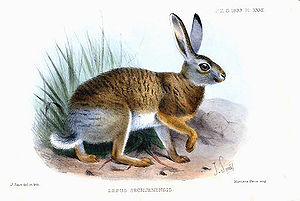Tibetan woolen bunny
| Tibetan woolen bunny | ||||||||||||
|---|---|---|---|---|---|---|---|---|---|---|---|---|

Tibetan woolen bunny, illustration by Joseph Smit (1836–1929) |
||||||||||||
| Systematics | ||||||||||||
|
||||||||||||
| Scientific name | ||||||||||||
| Lepus oiostolus | ||||||||||||
| ( Hodgson , 1840) |
The Tibetan woolly hare ( Lepus oiostolus ) is a species of the real hare among the lagoon animals . Its distribution area extends from northern India and Nepal over the highlands of Tibet to central China.
features
The Tibetan wool bunny is a medium to large type of rabbit and can reach a body length of approx. 40 to 50 centimeters. With an average of 45.6 centimeters and an average weight of around 2400 grams, the females are slightly larger and heavier than the males with an average body length of 44.6 centimeters and an average weight of 2150 grams. The head and snout are slightly longer than those of the related kaphase ( Lepus capensis ). The back color ranges from brown, yellowish-brown to yellowish-white, the fur on the back is slightly wavy. The trunk is brown-gray to silver-gray, the tail white or white with gray or gray-black stripes. The belly side is white, sometimes with a light brown line in the middle of the belly. The legs are brown-white, the fur in the area of the paws can be dark brown. The young are completely brown-yellow.
distribution and habitat
The Tibetan woolly bunny lives in the steppe and semi-desert areas in the highlands of Tibet . Its distribution area extends from the north of the Indian Union Territory of Ladakh , the Indian state of Sikkim and Nepal over the entire Tibetan Autonomous Region and parts of the neighboring Chinese provinces of Xinjiang , Qinghai , Gansu , Sichuan and Yunnan .
The habitat of the Tibetan woolly hare is at altitudes of 2500 to 5200 meters, in China usually above 3500 meters. It lives in semi-arid to dry grasslands, on mountain meadows, dry meadows and arid cold deserts in the Tibetan highlands.
Way of life
The Tibetan wool bunny is primarily nocturnal, but can also be observed during the day. It feeds mainly on grasses and herbaceous plants. The rutting season begins in April and the hares usually give birth twice a year, with four to six pups in each litter.
Systematics
The Tibetan woolen hare is assigned to the real hare of the genus Lepus . On the basis of molecular biological studies, the Yunnan hare ( L. comus ) was confirmed as a sister species.
A total of four subspecies of the Tibetan woolly hare are described: Lepus oiostolus hypsibius , L. o. Oiostolus , L. o. Pallipes and L. o. Przewalskii , the latter originally being assigned to the widespread Kaphasen ( L. capensis ).
Hazard and protection
Data on the population size of the Tibetan woolly hare are not available. However, the International Union for Conservation of Nature and Natural Resources (IUCN) assesses it as “Least Concern” due to its large distribution area and population size. In India, however, it was considered endangered due to the loss of habitat and the decline in populations. A decline in the population is also known for China and Nepal, but here it is not considered to be endangered.
supporting documents
- ↑ a b c d Jarita Ng: Lepus oiostolus in the Animal Diversity Web of the University of Michigan Museum of Zoology. Retrieved January 18, 2012.
- ↑ a b c d e f Lepus oiostolus in the endangered species Red List of IUCN 2011. Submitted By: Indian CAMP Workshop & CH Johnston, 2008. Retrieved on 18 January 2012 found.
Web links
- Lepus oiostolus in the endangered Red List species the IUCN 2011. Posted by: Indian CAMP Workshop & CH Johnston, 2008. Accessed January 18, 2012 Design.
- Jarita Ng: Lepus oiostolus on the University of Michigan Museum of Zoology's Animal Diversity Web. Retrieved January 18, 2012.
